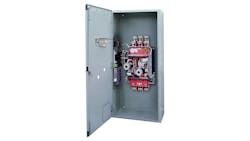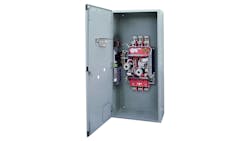All About Automatic Transfer Switches: A Guide
What Is an Automatic Transfer Switch?
An automatic transfer switch (ATS) is a means of transferring power between a primary electrical power source and an alternative source, such as a generator, in the case of power failure. Automatic transfer switches are critical for the smooth, consistent operation of facilities like hospitals and factories that require near-constant uptime.
While manual transfer switches require an operator and pose a variety of safety and time management concerns, automatic transfer switches can sense critical shifts in electrical power, such as the loss of the power source or when voltage frequency varies from a preset limit, and automatically transfer power from the alternate source. Additionally, they can detect when power is restored in the primary source and retransfer the load back.
What Does It Take to Make Them Safe?
Tried and true design and construction, in combination with a quality manual transfer system, is crucial to ensure the safety, reliability, and minimal downtime of an automatic transfer switch. This article will focus on open-transition transfer switches, where the switch breaks the connection with one power source before making a connection with another (also known as a “break-before-make” design).
One notable benefit of open-transition transfer switches over closed-transition power sources is the potential for external manual operators (EMOs), which are only available with the former. The EMO provides unparalleled ease of operation and safety measures not available in closed-transition transfer switches. EMOs allow you to transfer switches safely if an automatic transfer is not available, such as during a technological malfunction or controller failure, minimizing arc flare concerns.
Design and Construction of Switching Mechanism
For the safest and most consistently reliable manual transfer, three general requirements must be met: a fast transfer of power, protection against the danger of arc flashes, and protection against contact erosions. High-quality materials and segmented ATS contact designs are an investment in durability and reliability and will ensure your switching mechanisms withstand the test of time.
Fast Transfer of Power
As with any technological component, there are occasional automatic circuitry or programming failures. In this case, a manual transfer of power is necessary, and an expedient one will ensure limited downtime in the facility the transfer switch is servicing.
With some ATS designs, cabinet doors must be opened to perform manual transfers of the switch. Some even have a disable switch inside the enclosure which must be accessed to disconnect the automatic controls.
Recent safety requirements say that the ATS is to be disconnected from the two power sources in order for manual transfers to be performed safely. This adds more time to the transfer process and requires additional training to ensure the safety of operators throughout.
Russelectric open transfer switches are equipped with EMO (external manual operator) capability and a special crank that allows you to operate the switch through the cabinet door. This eliminates the need to open the cabinet door to perform a manual transfer thereby cutting down on steps to the transfer of power and ensuring speed in these crucial moments.
Without the ability to operate the switch through the cabinet door, exposure to components inside the cabinet is necessary. If an optimal ATS design is not chosen, a safe transfer process can become time-consuming, especially considering that many transfer switches are fed by switchboards and other feeder equipment, increasing the possibility for user error and possibly arc flash injury.
Protection Against Arc Flashes
Arc flash safety procedures require the cabinet door to stay closed. Not only do EMOs ensure this safety measure is met, but material differences can further cut down on the potential for arc flash danger.
Many transfer switches use electromagnetic solenoids that are directly linked to switching contacts. If an operator sticks a transfer handle into a solenoid, the contacts open and close at the speed of the operator’s hand motions. The slower the motion, the higher the arc flash danger.
Russelectric uses unidirectional linear motors that power a gearbox, which in turn drives an over-center mechanism that operates similarly to a mouse trap. The opening and closing speed of the contact does not change depending on the operator's motion. Such a unique design affords you an additional layer of safety, offering consistent speed and pressure for the opening and closing of the contacts.
Protection Against Contact Erosions
During an open-transition transfer, the Russelectric contact mechanism is securely locked in position until an over-center position is reached. At this point, preloaded springs instantaneously open the closed contacts (quick-break) and close the open contacts (quick-make) with only a momentary break in between. This quick-break design, when paired with rapid arc quenching features, provides the most effective rapid arc interruption under maximum voltage and amperage, which reduces contact erosion and overheating to extend useful life.
Russelectric transfer switches, for example, have some of the highest 480V AC 3-cycle closing and withstand ratings of any switches available today.
Click here to read more about Russelectric's latest products.
The Materials Difference
Russelectric’s switching contacts are machined (not cast, forged or stamped) from solid extruded copper with tungsten arcing tips. The switch’s mechanical linkages are crafted from sturdy anodized steel rods machined, not stamped or riveted, with aircraft-style ball joint fitting. Bus bars are made from solid copper, and silver plated. Additionally, the enclosure seams are arc-welded for extra bracing and smooth, ground corners. The holistically sturdy and tested design ensures smooth, safe function.
The tried-and-true design functions of Russelectric’s transfer switches are combined with cutting-edge technology, featuring a microprocessor that offers comprehensive control of the switch. The microprocessor can be incorporated into building management systems, a central office display, or can be web-enabled, making it fully integrable to existing processes. The display features clear visual cues, highlighting the display in green when it’s connected to primary power, displaying yellow when the switch is in transition, and red when the switch is connected to the alternate power source. These clear signifiers can eliminate complicated diagnostic procedures and allow operators to act quickly in the event of a power emergency.
External Manual Operators, a summary
An EMO provides a simple means for manual operation capability. EMOs are necessary when the automatic transfer system fails, or when completing ATS inspections. As noted above, the external operation ensures the enclosure door remains closed. This means safer operation and protection from arc flash injury, no need for additional safety protocols and training, and less downtime in facilities.
Russelectric EMO
The Russelectric EMO uses the same Russelectric transfer mechanism as the automatic electrical operator. The instantaneous engagement of the open-center position mechanism ensures fast switching regardless of the speed and force of the action of the human operator. This feature enables manual transfers of power to be fast, easy (without special, additional procedures), safe, and consistent.
Conclusion
Automatic transfer systems are critically important components of facility infrastructure. Under normal operation, they are fast, safe, and reliable means of keeping facilities running smoothly. When designed and built with quality in mind, they are robust and resilient to corrosion. Safety and operational features such as the Russelectric EMO offer an additional layer of reliability for fast, easy, and safe manual operation when necessary.
Founded in 1955, Russelectric, A Siemens Business, provides high-integrity power control solutions for mission-critical applications in the healthcare, information technology, telecommunication, water treatment, and renewable energy markets. The company maintains vertically-integrated manufacturing facilities in Massachusetts and Oklahoma, where it designs and builds a full line of automatic transfer switches, switchgear, and controls. To learn more about Russelectric products, visit www.russelectric.com, call (781) 749-6000, or email [email protected].
About the Author

Cleo Harrington
Freelance Writer
Cleo Harrington is an experienced copywriter, editor, and content producer for businesses across the technology, advisory, fashion, and audio industries.
She has 3 years of experience in Business Development and Account Management, an M.F.A. in Creative Writing, and a B.A. in English.

